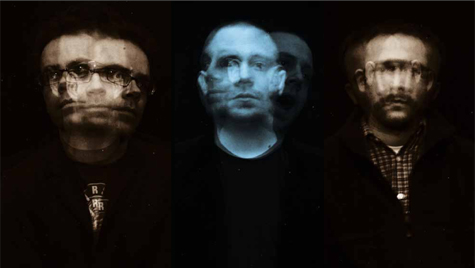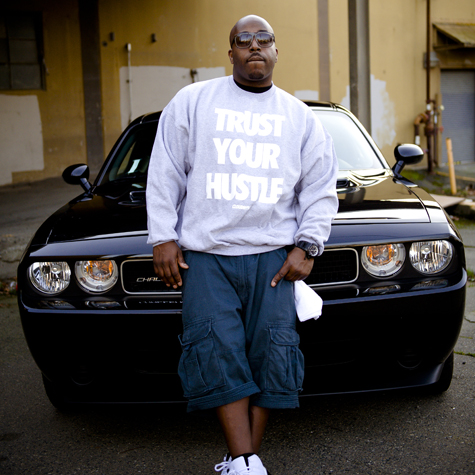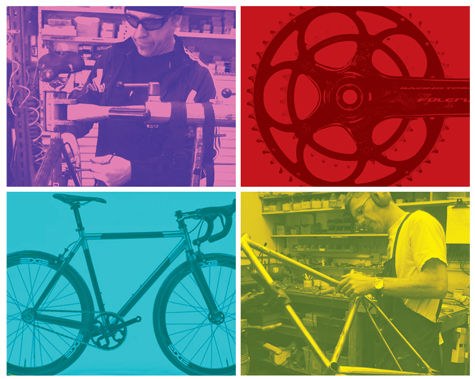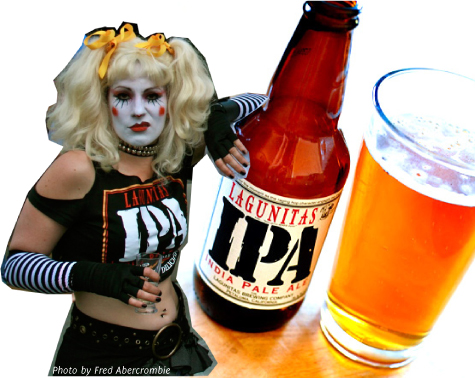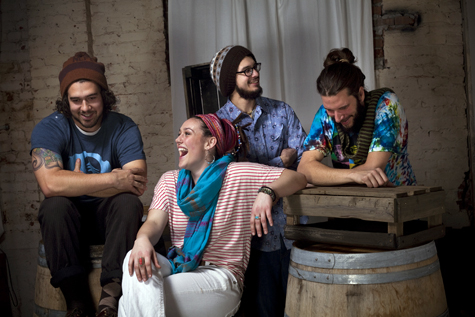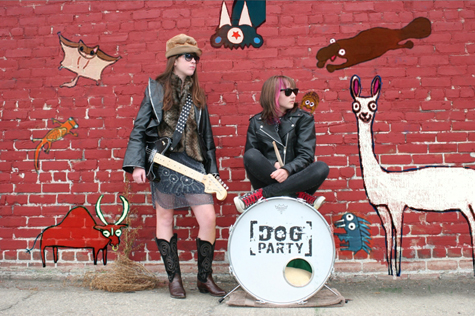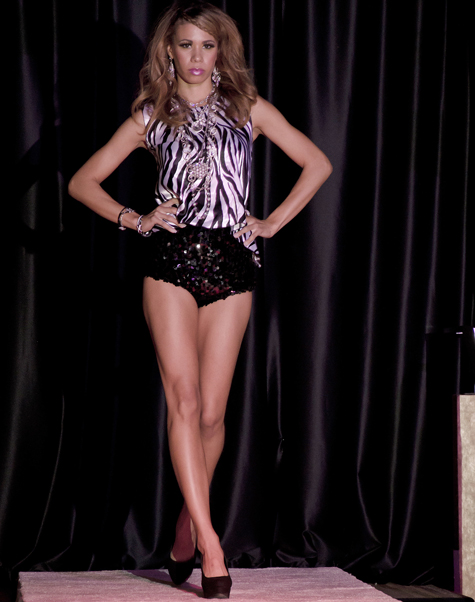The Inversions Forge Their Own Path
If you were the last person on Earth, would you kill yourself? It’s not something you probably mull over too much on an average day, but that’s the big question behind local band the Inversions’ song “Aloha.”
Usually, the word “aloha” makes me cringe. I immediately think American commercialization of Hawaiian culture, i.e., tacky Hawaiian shirts, someone adjusting a plastic lei around my neck and watching the worst adaptations of hula dancing imaginable.
This is why The Inversions’ song “Aloha” is genius. It plays on the meaning of the word in a very unpredictable way. There is not a single reference to sunsets or cheesy faux Hawaiian intonations to be heard. It’s just a rock ‘n’ roll song, pure and simple, using the word “aloha” for its double meaning of “hello” and “goodbye.”
The Inversions lead singer/guitarist Will Comstock is fond of lacing the band’s songs with double meanings, he says during a conversation with Submerge over beers at Pangaea Café. And “Aloha” is a prime example of just that.
Bassist/vocalist Ryan Offield is also in on this conversation. He explains that “Aloha” is also the title track of the band’s upcoming album because it’s the “most ridiculous” of the songs.
Like the rest of their work, including their full-lengths All Is Well and What’s the Cannon For?, Aloha will be released on their label Penwin Songs in April.
“Aloha is not much of a leap from our other stuff,” says Offield. Like their past albums, they have continued to maintain a groove-oriented melody, Comstock adds.
Though Offield and Comstock have been working together for many years (they met in their former band The Drowners), they have only been working on this project since 2006, starting with Frank French of Cake as their prior drummer.
The Inversions have only existed as The Inversions “proper” since 2008. Previously there were four members–Adam Varona was also on guitar. Now they are just three. Over time, they’ve managed to develop a sound that Offield has been told by fans “feels familiar, but in a new way.”
And since they discovered drummer Scott McConaha at Fox & Goose a while back, the trio seems to have found the right synergy.
For instance, “No Matter,” another song that will be featured on Aloha, is a song that the band has been wanting to record since it was written five to six years ago.
“I have no idea what ‘No Matter’ is about,” Comstock says. “But there is this unspoken understanding that it would be good for the band.”
Still, it’s only now that that the song will be included on an album, because, as Offield puts it, “Scottie got it right.”
Give “No Matter” a listen, and you’ll understand why it feels right. The song carries a steadfast beat under a simple guitar progression, straddling a rollicking, gypsy sound with a Western touch.
That said, it is curious that the band has earned a Brit-pop, indie rock rap.
Perhaps “LMAO,” the third song from Aloha that the Inversions shared with Submerge, bears the closest resemblance to anything of the sort. It’s catchy; it has that fleeting tempo and raucous strum pattern that is trademark of an indie pop song. And, as one might guess from the title, it’s about the Facebook craze, of all things.
Still, Brit-pop is not exactly the sound the Inversions are aiming for, Comstock says.
“It’s more a sound that’s been tagged onto us,” he says. “And any time you play minor chords with reverb, someone says you’re just trying to be Radiohead or something.”
“To me [our music] is rock ‘n’ roll,” he adds.
Certainly, Comstock and Offield are fond of British rock and pop, particularly of the ‘60s era. The band lists The Kinks as one of their top influences.
“I only have five [Kinks] CDs in my car,” Comstock says.
Otherwise, he’s been “geeking out” on the Coasters, jazz and Buddy Holly, he confesses, his black glasses tilted slightly down his nose.
Influences aside, the band doesn’t really look to other bands for their sound.
“We’re not aiming for anything,” Comstock says, “[Other than] does the song sound good, do we like it?”
Different rhythms, weird chords, good chord progressions and a good melody–these are things Comstock says he looks for when he writes a song. And apparently, he’s “prolific as hell” about his songwriting, Offield says.
“He’ll write more songs in a year than I’ll hear,” Offield laughs.
Writing, practicing and performing the songs are arguably the easy parts. They practice anywhere from one to five days a week downstairs in the Victorian where Offield resides. If they just keep up on their sound, the optimistic view is that everything else will fall into place. Yet the rest, producing albums and aggressively marketing, has been the “bugaboo,” Offield admits.
“When you’re on your own, things take a bit longer,” Offield says. “Our intentions are good…the road to hell is paved with good intentions.”
After Aloha, the Inversions intend to dive into producing their next album, a full-length.
As they produce material, Sacramento has continued to play a formative role in the band’s progress. The band has played countless times in venues across town, like Fox & Goose, The Blue Lamp, The Press Club, Marilyn’s on K and Naked Lounge. There was a time when they practiced at Sac Rehearsal studios. And in 2009 and 2010, the Inversions were nominated for a Sammie in the outstanding rock band category.
They’ve seen other successes, too. Their music was featured throughout the independent film Jake’s Corner, which played at the Sedona International Film festival in 2008.
After touring throughout the West, including the Bay Area, Portland, Phoenix, Seattle, San Diego and Tucson, Ariz., the guys have embraced an appreciation for Sacramento, the city where “you walk a little slower.”
“As you get older, you get a little more content and a little more satisfied with where you are,” Comstock says.
After all, Comstock only managed to get his hollow body Epiphone, which he uses for recording and shows, for a ridiculously generous price from a local in town.
It’s a city that is uniquely cool, Comstock concludes, and doesn’t deserve to be pissed on.
Now, Sacramento’s surroundings will serve as the background in a music video they are filming for “Aloha.” Director Jeff Weigt, who also filmed the music video for the band’s 2008 hit “Brain Dead Heart,” is currently working with the band members to capture a sense of apocalypse on camera, shooting around the nearby levy and wetlands.
Expect a lot of CGI and sweeping shots, Offield forewarns.
The video will likely be released around the same time as the album. And once the video is out, you can ask yourself what you would do if you were the last person on Earth.
The Inversions will celebrate the release of Aloha on April 14, 2012 at Blue Lamp. The show will get underway at 8:30 p.m. Aloha will be available via iTunes, but you’ll also be able to get yourself a torrent of it, if you’re so inclined, at http://torrentscan.com/, http://www.demonoid.me/, http://thepiratebay.se/ and other torrent sites.
Sacramento Fashion Week’s designer showcase hints at the season to come
The catwalk at the Elks Tower Ballroom had been dominated by the sexy, the doll-like and the glamorous up to this point.
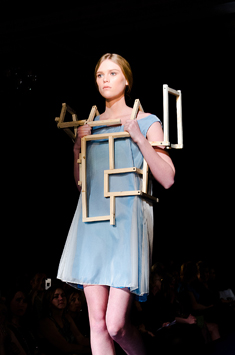
Designer: Amanda Chan
Now the energy in the room had taken an unexpected turn, when, one after the other, a sequence of models took to the stage, each wearing a different shade of the same sleeveless, A-line dress with the same unblinking, empty stare. The clicking of camera shutters and flashes doubled in speed. Mysterious classical music guided the models in their solemn walk down the runway, each one wearing a maroon, sky blue, tangerine orange or pink dress with flats. Atop their stiff shoulders rested oversized wire or wooden cages confining their arms and necks. Some of the cages were crafted from Jenga-like wooden blocks, while others were wire-wrapped, strung with bits of moss or glass baubles.

Designer: Amanda Chan
This was local designer Amanda Chan’s line, ZuBauen, closing the first night of Sacramento Fashion Week’s designer showcase. Sacramento designers brought color and flair to the showcase at the ballroom Friday night; however, no designer statement had been more artistically profound than Chan’s.
For about two hours, models strode on the runway beneath high ceilings and chandeliers, flanked by rows of chairs on either side, not an empty seat in sight. To the left, booths filled with VIP guests hung overhead.
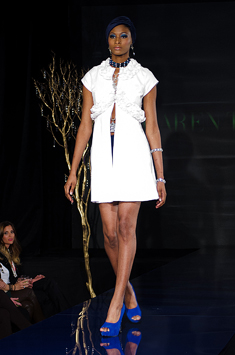
Designer: Caren Templet
In addition to Chan, the evening featured designs by Caren Templet, Dee Aguilar, Michael Lopez, Gina Kim, Janelle Cardenas, Nelli Rosh, Casey Sue and Jocelynn Brown.
If the designer showcase was a realistic projection of what is in store for women’s fashion this spring and summer, then expect a lot of trousers, high-waist pants, short dresses and skirts, drape-y tops and tailored blouses and jackets.
Take Lopez’s line, for instance. In a light, dreamy presentation, his models appeared doll-like and delicate, in soft colors and feminine cuts. They donned high-waist trousers and silky skirts, with collared-tops, floral prints and lace-up, heeled boots.

Designer: Jocelynn Brown
Brown’s pieces reminded that spring is upon us, drawing from a pastel palette of colors. Her designs were sweet and lighthearted, incorporating blouses, shorts and knee-length dresses. One model appeared in a baby blue top tucked into high-waist yellow shorts, another appeared in a sea green blouse with high-waist baby blue trousers, and yet another appeared in a lavender cap-sleeve blouse with a knee-length skirt.
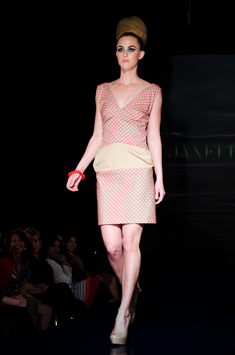
Designer: Janelle Cardenas
A remixed version of Nancy Sinatra’s “Bang Bang (My Baby Shot Me Down)” and Amy Winehouse’s “Love Is a Losing Game” appropriately accompanied Cardenas’ models along the runway. The looks were palpably ‘60s-inspired, as the models brandished huge beehives atop their heads, matched with heavy eyeliner, red, patterned prints and above-the-knee sleeveless dresses.
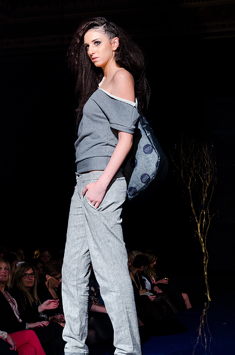
Designer: Gina Kim
Kim’s designs were subtler. Her models sported big, crimped hair with mostly gray and relaxed yet elegant pieces. Several outfits were matched with clutches and handbags. Gray shorts, trousers and miniskirts were paired either with an off-the-shoulder sweater, a tunic or an asymmetrical tee.
Sue’s line mixed funky and casual pieces, muted tees and tank tops paired with short floral skirts and makeup that popped. Models entered the stage to the beat of Métisse’s “Boom Boom Bâ” wearing combinations like an above-the-knee skirt matched with a purple tank and turquoise lipstick; an orange, gray and white dress with gray lipstick; or a short, a black vest over a tee-dress with turquoise lipstick.
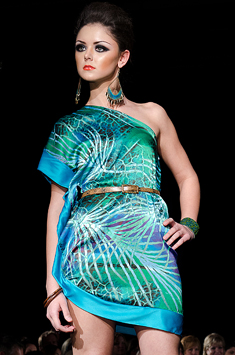
Designer: Dee Aguilar
Brighter and more colorful was Aguilar’s skin-baring line, complemented with a flurry of electro music. Models approached the crowd in a flashy fusion of sherbet colors: an orange top matched with bright purple harem pants, a dress with yellows, blacks and pink, a blue flutter sleeve dress with an orange necklace. The cuts were sexy–open-backs and cut-out shoulders, thigh-high dresses, and strap-y or strapless tops.

Designer: Nelli Rosh
Rosh’s clothing brought a comparable level of va va voom to the runway, balanced with sexy elegance. The first of the models emerged in a white, loose-sleeved blouse and ink-black, floor length skirt, while another model wore a brown, elbow-length blouse combined with a pink, loose, asymmetrical skirt. Other models traipsed onto the runway in tube or ruffled mini-dresses, completed with elbow-length, satin gloves or blazers. The final ensemble took the cake: a floor-length bright red sparkly dress. Jessica from Who Framed Roger Rabbit? immediately came to mind.

Designer: Caren Templet
Templet’s theme, White on Ice, was characterized both by elegance and sophistication. One by one her models appeared on the stage, their looks tailored and classic, in blouses, trousers and cap-sleeved jackets. Adding touches of glamour, the looks were accessorized with blue turbans, chunky crystal necklaces and royal blue, peep-toe heels.
Templet herself had played a large role in orchestrating Fashion Week. It had been no easy task, she reminded the crowd just before the showcase. The chaotic nature of organizing this kind of event is an indication of the goal at hand, she explained to the audience. The aim of the showcase, and of Fashion Week, is to elevate Sacramento to its rightful capitol status, she said, and make sure that New York happens here.
Considering New York fashion involves substantial edge, this vision may be in the distant future. Most attendees of the showcase played it safe in attire choices themselves. The women showed up in solid-colored dresses, chunky platform heels, colorful blazers, and sequin tops and skirts abundant. The ratio of women to men in attendance at the showcase was about three to one, an eclectic mixture of middle-aged and younger guests in the crowd. The men in attendance, particularly the photographers, appeared dapper, but also played it safe, clad in bow ties, white suit jackets, and dress shirts with vests.
There was the occasional spotting of bold fashion statements–teased hair, a crystal-embellished black fedora, a colorful Betsey Johnson necklace with a protruding plastic bird on it, or trendier pieces–i.e. black floppy hats and high-waist skirts.
But for Sacramento, this is perhaps as New York as it gets.
Mean Doe Green (aka Doey Rock) has tasted success, but it hasn’t sated his appetite
It’s a quiet Saturday night in New Era Park. Smack in the middle of this seemingly lifeless block between D and E streets is the firehouse, a distinct two-story brick building with ghostly white faces engraved above the front entry. This is the home of SoundCap Audio, the tracking and mixing studio that has produced albums by some of Sacramento’s top hip-hop artists. I’m here to meet with Sacramento’s veteran MC Mean Doe Green. You may also know him as Doey Rock.
Born Kahallie Oden, Jon Doe was the first moniker Green chose for himself when he started rapping. That soon evolved into Doey Rock. Incidentally he dropped “Mean Doe Green” in a rhyme, and as someone who adopts different personas in his music, he has embraced Mean Doe Green as an alter ego ever since.
“It was a way to reintroduce myself to people,” he later explains. “But I’m never afraid of Doey Rock, because he did a lot for me, too, alter ego-wise.”
Back at SoundCap Audio, engineer Pete Rodriguez answers the door and leads the way past the sound booth to the mixing room. The place is dimly lit and quiet. We shoot the breeze while we wait for Green to arrive. The young kids, some of them as young as 17, are the ones really tearing it up in the local hip-hop scene, he tells me.
Minutes later Green strolls in and makes his way to the black leather couch across from Rodriguez. His voice booms, loud and lucid, but he’s all jokes and smiles. This place is a safe haven for his music, he says, where he feels comfortable enough being himself while recording.
He and Rodriguez have been a team since Green began recording at Sound Cap more than two years ago. Green’s 2010 release Mind Candy Re-wrapped, as well as mixtapes Black Suits and Shovels and Hard Hats and Hand Grenades, both released last July, were recorded here. Now the two are working on the final touches of Shade Proof, Green’s upcoming LP, which is scheduled for release on Feb. 21.
It has been a three- to four-month project that has resulted in a very aggressive, “in-your-face” approach, Green later discloses, which he says will likely make listeners either love or hate him. Teaser tracks “Be Great” and “Thankful” are already posted online, both of which have attracted attention in the hip-hop blogosphere.
Though it features the likes of R&B artists Hello World, Raekwon, Tommy Nova and Arty Fresha, Shade Proof is meant to highlight his capabilities as an MC, front and center, Green says.
“I felt like I should put more of myself [into it], because I think a lot of albums that come out just have too many features,” he explains. “Hip-hop albums these days are just about who you have on the album, as opposed to the artist that’s presenting the album.”
Green only exposed Submerge to four select tracks from Shade Proof.
“I’m picky as fuck about my music being played for people,” he says.
But in those tracks alone, which include “Be Great,” Green opens up over grimy beats. And there’s a lot to open up about. He had a neglectful father. He grew up in the hood and has seen his share of “wild shit.” He watched family members fall victim to drug abuse. He watched someone get killed in his driveway.
At the end of the day he’s a street dude, he says. But that’s how he met Raekwon of Wu Tang Clan at age 17, before anyone knew who Wu Tang Clan was. That’s how he got introduced to the game of hip-hop, and he’s been at it ever since.
“I’ve been feeding kids off hip-hop, and I’m proud of that,” he reminds.
Mid-conversation, Green asks Rodriguez to bust out the weed. Rodriguez pulls out a massive nug the length of a pen, and the two get to business rolling a joint.
“Welcome to the city of trees, God dammit,” Green says.
Soon enough they’re getting ripped, and Green is answering my questions with more and more ease. Next thing I know he’s getting stuff off his chest, stuff about the commercialization of hip-hop and about the passion that fuels his songs. The following gives a taste of the conversation.
When do you think [Shade Proof] will be done?
It’ll be out on the 21st, because that’s the date we set, and I don’t have a choice. And when it’s out I’ll be happy with it, because I work well in pressured situations for some odd reason. But I’ve been MCing for so long at this point finding comfort zones is different now, because quite frankly I’m not in the same hunger state that I was in four years ago.
What do you mean?
Yo, MCing is about hunger. This shit was created because people didn’t have shit to do when they was starving and they wanted to put their talents on display. That’s what MCing is about, “I have something to say, hear my voice.” The greatest artists were hungry artists, if you think about whether it’s Tupac and Big, or go back further, Run DMC or Raekwon or Afrika Bambaataa, or whoever. They was starving, not only for attention, but: “Yo, I have a talent to put on display, I have a message. This is my style.” Hip-hop is about your style and your energy as a person. So me doing this for so long, and doing it successfully, you have to find hunger, you have to have a reason. Driven… I have pockets of, “Well I don’t even like rhymes,” because I don’t have shit to say. I done fuckin’ made it to the suburbs. That nigga from Elder Creek? Where I’m living at? Damn! I’m so realistic with my music, I don’t have anything to cry about or complain about, so it’s hard for me to find pockets of hunger. But let an MC think he’s better than me. Those are my driving forces now. It’s different driving forces as a real MC, because I’m not going to write no fabricated shit. I’m not going to rap about binges and mansions and luxuries, this, that and the other. Now I’ve got to find pockets of, “Oh, I feel hungry,” or “Oh, I heard a Chuuwee song, damn that little mothafucka tight! I gotta do that.” But it’s healthy competition, not like I’m hating on him, but that inspires me now.
What were you thinking about when you wrote [“Merlot Murder”]? I felt like there was some anger in that song.
Anger toward hip-hop, right?
Mhmm.
You know what? As much as I felt like I gave to hip-hop, and I tried to stay true to it, I felt like it kind of stabbed me in the back in ways. I feel like it didn’t afford me opportunities that it should have. I don’t know if it was being from Sacramento, I don’t know what it was, but I feel like honestly, as true as I stay to this sport, look at what hip-hop is right now. You got a lot of pop bullshit out, you know, it’s just so watered down.
What’s the ultimate example of watered-down hip hop to you?
When you want a better life for your family and where you come from, I don’t blame people for doing what they do to make money. I guess I’m just so personal with hip-hop that I hate that it comes at the expense of hip-hop. So, watered down to me would be–and it’s a thin line when I say this and it’s a slippery slope–anything that goes commercial to the point that you know what you’re broadcasting is not from the heart. The problem with saying names is you don’t know what their family situation was, and I always am careful about that… See it’s a lot of driving forces as to why we do what we do in this game. The problem is, look what hip-hop has become because of the money and because of the bling-bling era. I guess I would lay the blame there, the bling-bling era of hip-hop fucked it all up. Anytime you give people with nothing a vision of people that didn’t have nothing and now they got something, anytime you broadcast that too much, it becomes, now the people with nothing are rapping about shit they don’t have because they want to look like that. And it just misconstrued every damn thing.
Why do you think you weren’t [rapping about personal stuff] before?
I just wasn’t. I was just on the MC shit, let’s focus on the art and this and that. We’re not going to talk about the street. I didn’t want my gimmick to be street shit or gangsta shit, I don’t claim to be a gangsta in the first place… I’m not doing it for any specific reason. I guess at this point I just feel like I should get it off my chest.
Doey Rock will celebrate the release of Shade Proof (out March 13) on March 16, 2012 at Harlow’s. You can listen and download the the album at Audiomack.com/artist/doey-rock. The show starts at 10 p.m. and will cost $10. To order tickets in advance, go to Harlows.com.
Local bicycle enthusiasts team up to bring the prestigious North American Handmade Bicycle Show to Sacramento
To anyone who has ever owned a bicycle, it’s a universal reality: all the pleasantries of a bike ride quashed by a bicycle chain mishap. Nowadays, however, there is such a thing as bicycles without chains. These bicycles are belt-driven; rather than being equipped with a chain, they are equipped with unbreakable, motorcycle-style belts.
There is a market for these bikes, just as there is a market for bikes made of carbon fiber, in addition to bamboo.
Some of the industry’s most innovative bicycle designs are being generated not by manufacturers, but rather by handmade bicycle frame builders.
As with any niche, when you get into talking about the specifics of how a bike is made and the materials used, the discussion easily becomes esoteric. But regardless of whether or not you can keep up with the bike jargon, if you have even the slightest interest in bicycles, then the North American Handmade Bike Show (NAHBS) is a must-see, says Don Walker, longtime bike frame builder and the show’s founder and president.
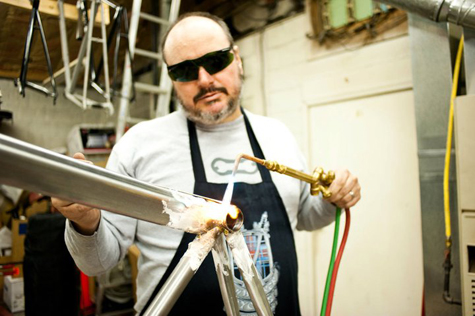
Don Walker
This is the one opportunity of the year where bike enthusiasts can see “eye-popping, over-the-top, beautiful, yet functional, bicycles,” Walker explains. “In my opinion, there are no better bikes on planet Earth in any one location other than the NAHBS show once a year.”
Nor is there a larger gathering of bike frame builders that occurs anywhere else in the world than the gathering at NAHBS, he adds.
The three-day show, now in its eighth year, will come to Sacramento. This year, 158 exhibitors will be featured at the show, the highest number of exhibitors at any NAHBS show, with the exception of last year in Austin, Texas. (There were 174 then.)
Builders will compete for “best of” categories based on the type of material used, the style of the bike and frame, the finish and overall best builds. Handmade bike frame builders coming from as far as Italy, France, Japan, England, Denmark and Canada, and as close as Texas, Oregon and San Francisco, will spend three days at the Sacramento Convention Center showing off their best work.

Track bike by Don Walker Cycles - Urbanvelo.org
The concept of a handmade bike frame is not unlike that of handmade clothing, local bike enthusiast Rick Houston says, in the sense that it is a high-caliber item tailored and customized to fit an individual.
Houston, co-founder of Sacramento Tweed, a mass gathering of cyclists who don vintage and tweed during big bike rides around town, is also primarily responsible for bringing NAHBS to Sacramento this year.
After reading his fill about the show in bike magazines, Houston made a spontaneous phone call to Walker in January 2010 asking him to bring the show here. Though he had been absent for some time, Walker just so happens to be a Sacramento native who grew up in the Arden-Arcade area and used to cycle race in Sacramento in the early ‘80s.
The next time Walker was in town, Houston met with him over burgers and beer at Rubicon and pitched a list of reasons why the show should come to Sacramento: the city boasts a mild climate, flat topography, and a solid infrastructure, he explains. Not to mention that the headquarters of the California Bicycle Coalition is based here, and the U.S. Bicycling Hall of Fame in Davis.
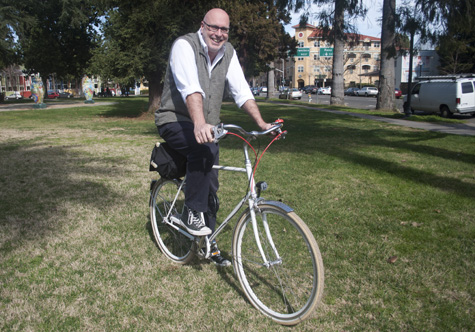
Rick Houston - Photo: Jenn Walker
“Sacramento is a great bicycling city,” he says. “We have advantages that Portland can’t dream of.”
After making his case, Houston successfully convinced Walker to make Sacramento the 2012 NAHBS destination.
This year’s show has certainly evolved from its beginnings eight years ago, Walker says. The show grew out of an online handmade bike crafters forum, he explains, and was first held in 2005 in Houston, Texas. In addition to featuring work by some of the world’s top handmade bicycle frame builders, it was meant to provide an opportunity for beginning builders to network with the pros.
That show featured 23 exhibitors. Walker realized he was on to something when 600 to 700 attendees came through the doors over the course of three days.
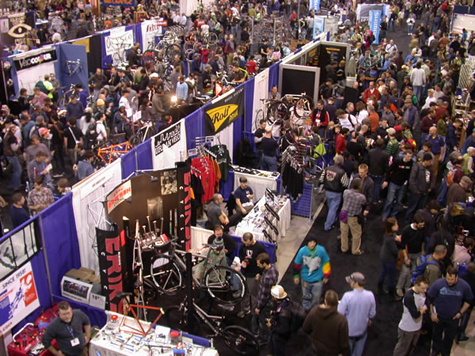
NAHBS 2010, Richmond, Viginia - Photo: Dave LaMay
“My mission in life at that point in time became: make sure that every cyclist on Earth knows that if they’re interested, that they can buy a handmade bicycle, usually for less than they can than a brand production model if it’s made in China,” he says.
Awareness of the show is increasing exponentially. At the San Jose, Calif., show in 2006, there were four times as many exhibitors. NAHBS has become an internationally acclaimed event for the cycling industry, and it is now maxed out in capacity.
This is the one show that bike builders can look forward to, Walker says, because they can show their best work, and the whole world will see it, either through the media or viral online buzz.
“[Bike builders] understand that NAHBS is the best bang for their marketing dollar,” he adds. “It’s those guys and gals that really dig your stuff that will take a picture and post it somewhere.”
Walker, who himself has built close to 500 bikes since the start of his building career in 1991, will bring his handcrafted steel bikes from his two-garage operation back in Kentucky to the show.
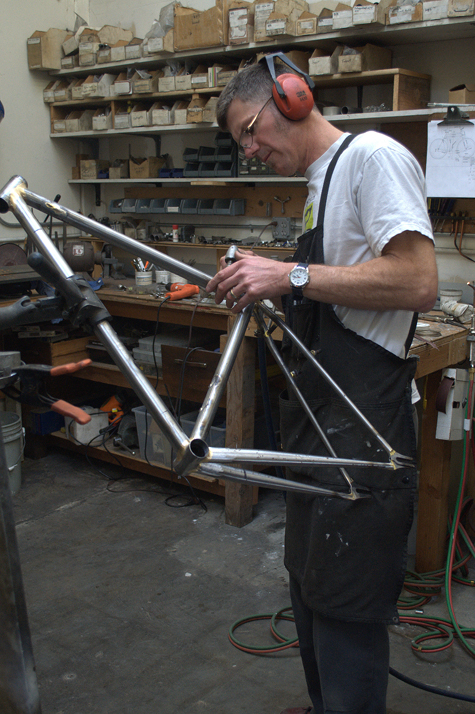
On the local front, Sacramento’s Steve Rex will have an exhibition featuring a variety of his work. Being the only handmade bike frame builder in Sacramento, he stays pretty busy building bikes for recreational and sport riders within the Northern California region alone. As busy as he is, he is still participating in this year’s show.
“I love Sacramento, and I think [NAHBS] will reflect well on the city,” he says. “There will certainly be buzz about it for a couple of years.”
Coincidentally, the show overlaps the 25th anniversary of his building career. A tribute event is planned in which all the fundraising proceeds will go to Sacramento Area Bicycle Advocates (SABA).
To date, Rex has participated in three NAHBS shows; his bikes were on display in 2006 and 2007 in San Jose, as well as in Portland, Ore., in 2008.
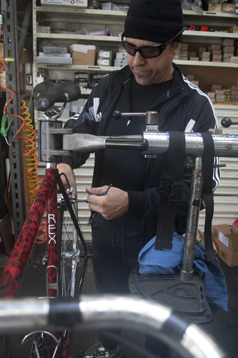
Dean Alleger - Photo: Jenn Walker
The day Submerge paid Rex a visit, he had been working on building two bikes: a single-speed cyclo-cross bicycle and a road bike, both fillet-brazed. If fillet-brazing is lost on you, just picture this: it is when two tubes are fused together without being melted, instead only the joining or filling material melts, Rex explains. It is a less-commonly used technique that requires more time and patience in comparison to the Tungsten Inert Gas (TIG) welding method, he says.
Once a cycle racer, now Rex’s days are spent building bikes from steel and carbon fiber, whether they are mountain bikes, tandems, road bikes or cyclo-cross bikes. He specializes in building fillet-brazed bikes with carbon tubes and steel joints. The carbon tubes are glued into the steel lugs, or joints, he explains.
The carbon fiber he uses is sourced from and custom-made in Utah, and the steel is from a plant in Missouri. A Rex bike can take anywhere from eight to 20 hours to make; and, considering he is the only one in the shop who actually makes the bikes, it’s understandable that delivery time ranges from three to five months.
Whether from near or afar, the common denominator between NAHBS exhibitors is the high quality of craftsmanship they bring to the show.
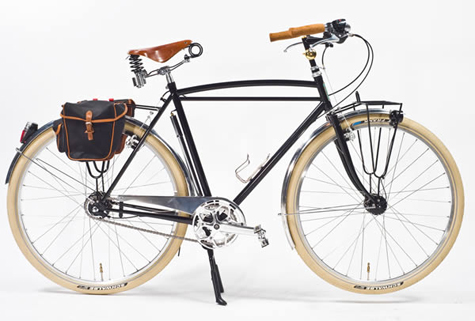
City bike by Alternative Needs Transportation - Urbanvelo.org
“Everybody is bringing their A game [to the show] every year all the time,” Walker says. The show always has been, and will continue to be, about bike fanatics, he adds.
“We’ve got all walks of life that come in [to the show],” he says, “from new cyclists to veteran cyclists, people who have been riding for 40 years or more.”
Based on past years, NAHBS expects 30 to 40 percent of attendees to come from outside of the state, 15 percent of whom will be repeat visitors. Of the 158 exhibitors, Walker estimates that 15 to 20 will be international, while the rest will be from within the country.
Needless to say, there are countless hands involved in setting the 2012 NAHBS show into motion, Houston says. He himself has been working with about 200 volunteers.
“The volunteer spontaneity overwhelms me,” he says. “I don’t know what kind of city we are, but we are an amazing village.”
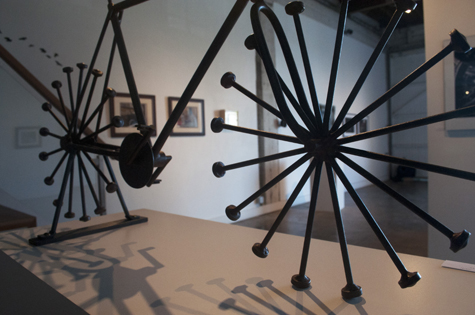
Eddie Stein - Photo: Jenn Walker
Apropos to Houston’s statement: To show how enthused locals are about the bike show and about bikes in general, within about a month, Sacramento volunteers have organized ArtBike! in conjunction with NAHBS.
In short, it is an art project displayed around the city that pays homage to bikes. Photos, sculptures, paintings and mixed media depicting the two-wheeled machine are featured at Cuffs, The Golden Bear, Milk Art Gallery, First Edition and the Ancil Hoffman Golf Course.
The objective is to express just how much of a creative and bike-friendly city Sacramento is, says ArtBike! organizer Julia Beckner.
The project will culminate on March 3, 2012 with what Beckner describes as a Burning Man-esque bike parade starting at the Convention Center.
Expect the absurd, Beckner warns, including a 5-by-5-foot hollowed toaster that will be maneuvered by cyclists.
“It will blow people’s minds,” she says.
Expectations aside, Houston forecasts that, considering 20 to 30 percent of the Midtown and downtown crowd spends time on a bike at any given time of the week, either commuting or leisure-riding, NAHBS should have a huge turnout.
Regardless of what cyclist tribe you identify with, whether it’s the fixie riders, the road racers, or the mountain bikers, there’s something for everyone at the show, he says.
Naturally, he has invited anyone and everyone, including Congresswoman Doris Matsui. We’ll see who shows up.

The North American Handmade Bicycle Show will occupy the Sacramento Convention Center March 2 through March 4. Three-day passes cost just $50, and single-day passes are also available. For more information on this event and ArtBike!, go to 2012.handmadebicycleshow.com.
Beer? Circus? Of course we couldn’t let the Taste section run without some mention of Sacramento’s third annual beer week! Stop by Dad’s Kitchen on Friday night to see attractions from Lagunitas’ renowned beer circus, hosted by Sacramento Lagunitas rep Justin Seybold. Just $6 gets you a logo pint glass that you can refill for $4 throughout the night with your pick of Lagunitas brews. The madness will flow from 6 to 9 p.m. on March 2. Dad’s Kitchen is located at 2968 Freeport Boulevard. Keep in mind beer week runs Feb. 24 through March 4, so if you can’t make this one, keep an eye out for some of the other events. Visit Sacramentobeerweek.com for more information, or to join the mailing list if you really want to stay on top of things.
Jesi Naomi finishes up her first album with The Trippers
For Jesi Naomi, energy is everything. If you focus your energy on the things you desire, and release that energy out into the world, you will attract the things you want in life.
So once she had her mind set on playing music back in 2009, she took some advice from her aunt. She began telling everyone she knew that she was going to become a musician.
Next thing you know, the singer/songwriter was singing ballads at Capitol Garage. Then she met local indie band Bell Boys at Fox and Goose downtown during an open mic night, and they helped her learn the tricks of self-promotion. Later she met local jam band ZuhG, of which she is now a member.
When Naomi is playing solo, ZuhG members JR Halliday, Bryan Nichols and Kevin Martinez comprise her backup band, altogether as Jesi Naomi and the Trippers. In March she will go on a two-month “For the Love of Music” tour, performing both in ZuhG and as a solo artist.
Two years into the music scene, the 24-year-old is now preparing for Jesi Naomi and the Trippers’ debut album, Earplay, to be released in January.
Earplay is seven tracks of blues and soul combined with psychedelic nuances and djembe, saxophone and ukulele thrown into the mix. It was recorded in the span of around three months by Joe Johnston at Pus Cavern.
The album opens with “Kosen Rufu,” which is the title of both the intro and outro tracks. It is also a guiding theme of the album. Broadly defined, it is world peace through individual happiness, a concept stemming from Buddhism. As a practicing Nichiren Buddhist, this concept is paramount for Naomi.
“[Kosen Rufu] is world peace by making each person have their individual peace,” she explains.
Certainly this applies to the song “Change Train,” which Naomi wrote for her mother, who was an alcoholic.
Her mother’s attention was constantly split between her children and the bottle, and Naomi remembers thinking, “If I write this song, I want her to find her change train. If I sing this song as many times as I can, she’ll get better.”
A year later, after performing the song show after show, her mom told her she had gone sober.
Though school had never been Naomi’s thing, it is what brought the Chico, Calif., native here to Sacramento. Naomi thought she was going to make music videos for a living. She was enrolled at Sacramento State as a media/marketing major.
Yet reading, comprehension, spelling, memorizing was the sort of thing she felt detached from. Whenever she hit a burn out point, she would think to herself, “Forget this. I’m gonna go paint.” Up to this point, painting had been her artistic release.
But somewhere along the way she discovered the pianos in the music rooms at school. Then a guy by the name of Richard Martin started listening in on her practicing piano and pushed her to learn scales.
“That’s where it all started,” she remembers. “I just needed a little direction.”
That Christmas her younger brother taught her how to play the guitar, something she thought she would never be able to do, mostly because the thought of memorization intimidated her. But memory is just a muscle, she can now say with confidence, and what’s more important than memorization is feeling the music. And she has come to realize that she’s got music coursing through her veins.
“Music is in my blood,” she says earnestly.
You could say Naomi is following in her father’s footsteps. He played drums in a band called Pole Cats back in the day and went on tour when she was still in her mother’s belly. Though he’s no longer in a band, he played drums on the track “Hold Me Nice” on Earplay. It is the first song Naomi ever wrote, back when she was learning how to play piano.
She often catches people by surprise when she reminds them that it’s only been two years since she started playing music.
“There’s no better way to learn than to just get thrown into the deep end and hope to swim,” she laughs.
Yet when she is performing it is as though she’s been a musician on a stage all her life, as though that is where she is meant to be. She wields a sense of confidence and power that is hard to come by in a performer.
Offstage Naomi is warm and easygoing. Sitting in the practice space behind the ZuhG Life store, she sips on Earl Grey tea and speaks effortlessly about her music in a conversation that lasts a good 45 minutes. She wears an enchanting smile on her face and responds coolly in a bluesy tone.
Make no mistake that this is a woman with self-respect.
In a way, Naomi says, women have it easier in the music world because they are more marketable. The notion is that they just have to look good.
“That in turn makes it harder for a woman to really put out her true soul,” she says.
“I’m not going to go up there and wear some skanky outfit and not know what I’m singing,” she continues. “I want the music to shine, that’s pure beauty to me.”
Still, she’s been approached by the occasional creep for the wrong reasons.
There was one, she recalls, who made himself out to be the big-time producer who would get her work noticed.
“I thought I was going in to make a demo tape, [but] it wasn’t like that,” she says. “Thank God my mom raised me to know about those kinds of things.”
She went her separate way, with her mind in one place. It’s all for the love of music.
And despite the few exceptions, Naomi says she’s received a wealth of support from her male colleagues.
“I feel like I get a lot of respect being a [female musician], especially if I respect myself,” she says.
If that is the energy Naomi puts out into the universe, certainly that’s what she’ll receive.

Jesi Naomi and the Trippers will be putting forth positive energy at Marilyn’s on K Jan. 7, 2012 when they celebrate the release of Earplay, a seven-song EP. There will be a $10 cover, which will include a copy of the CD. Also playing will be Brad Relf, The Bell Boys, James Cavern and Monkey Flower. Show starts at 8 p.m.
Dog Party’s new album cause for extra exclamation points!
What do teens and preteens do these days? What are they into? One could guess: Twilight? The Kardashians? Justin Bieber?
Maybe. Or maybe that’s just brushing the surface.
Local sister duo Lucy and Gwendolyn Giles have been playing in their rock band Dog Party since they were only 9 and 11 years old, respectively. Now Gwendolyn is a sophomore in high school, and Lucy will have her first taste of high school starting next year. At 13 and 15 years old, they are preparing for release of their second album, P.A.R.T.Y!!!, which they spent a good half year recording.
The Giles’ mother drove the two to Shine café in downtown Sacramento for an interview with Submerge about their upcoming release. They look older than they do in the pictures. Bits of bright purple and pink flash from underneath Lucy’s brown bob. She is wearing a Ramones shirt beneath a black pleather jacket with skinny jeans and Chucks–a Joan Jett in the making. Gwendolyn appears a bit more subtle, dressed in a gray hoodie, jeans, Saucony tennies and a checker belt.
One thing you should know about these girls is their musical upbringing. Their father, bless his soul, chose to introduce the two to “good” music at an incredibly young age–their musical tastes include The White Stripes, The Black Keys, the Beatles, the Ramones, the Beach Boys, Green Day, LCD Soundsystem and CSS.
Take a listen to P.A.R.T.Y!!! and you get the idea. From the screeching of Gwendolyn’s phaser pedal on the album’s first track, “That’s What You Said,” the sisters brandish their rock roots. But in the midst of the album’s power chords and cowbell taps, other songs expose a folksier side, like “Mixed Up Lovers,” or a gypsy punk flare, like “Red Ribbon.” Lucy was listening to a lot of Gogol Bordello at the time, she discloses.
Then there is “Memories,” which is by far the hardest song on the album, plunging into a metal sound. It’s about not being able to ski in the summer, Lucy says to me. Note that most of their songs are not so melancholy. They sing about the likes of a furry friend on “Chih-Iro,” for example, or their photographer acquaintance on “Andy Wu.”
Regardless of whatever sound they’re going for on a given day, they have always loved music, they say. Gwendolyn had picked up the guitar and was playing talent shows at school by fifth grade. Lucy wasn’t far behind. Looking to Meg White of The White Stripes for inspiration, Lucy wanted to play the drums as early as first grade, she remembers.
“I thought it was normal to be a girl drummer,” Lucy says.
Her dad bought her a Reuther drum set that year, but she would have to wait until third grade before she could take drum lessons.
Unlike many of their peers, they managed to escape the magnetism of Miley Cyrus or Kelly Clarkson. With a little push from family friend Zach Goodin, they formed Dog Party in 2007 instead.
The White Stripes and The Ramones are high on their influence list, the latter of which Lucy admits an obsession with. While the girls were in Southern California for a photo shoot with Tom Tom Magazine over the summer, she insisted that her family stop at the Hollywood Forever Cemetery to see Dee Dee and Johnny Ramones’ graves. An artist as well, she pulls out her phone to show pictures of stencils she made of each Ramone’s face.
Indeed, the girls are comfortably familiar with a lifestyle that their friends are strangers to. The last show Gwendolyn tried to drag her friends to was a Secretions show at Luigi’s. And apparently it freaked them out, in the same fashion that their friends are scared to come to Midtown in general, preferring the ‘burbs of Carmichael, Gwendolyn bluntly says.
“I don’t like being in the ‘burbs,” pipes Lucy.
This is not to say that the girls don’t have friends their age. Ski team and cross country help to keep the girls socially connected. In fact, ski racing in Squaw Valley was one reason why the album took so long to record, since often the girls only could record one to two days a week.
But when it comes to playing music with friends their age, the pickings are slim, they say. The kids at school are mostly “band people,” Lucy states dismissively. Rather, the two find musical support from Midtown musicians, namely adults. They’ve played a number of shows with Kepi Ghoulie, who just released an album himself. In fact, the Giles family had just spent their past Sunday at Bottom of the Hill in San Francisco for Kepi’s show.
Goodin has been helpful schooling the girls on gear. They rattle off gear specifics with ease. Gwendolyn rotates between her sister’s Fender Squire Strat, a couple of Silvertones, and a Hofner paired with a Fender Pro Reverb amp and Marshall cabinet.
Goodin also released P.A.R.T.Y!!! on his label, Half of Nothing records.
The girls have grown accustomed to playing with musicians older than themselves. In addition to Dog Party, they are also half of Sacramento band Little Medusas with two older counterparts.
They also just completed a two-week tour through Arizona, New Mexico and Southern California over the summer with Ghoulie and Sacramento band Pets, playing half their shows in houses and the other half in bars. By far, their best show was at a house party in Flagstaff, Ariz., Lucy says, because people were actually moving instead of just standing around the way people tend to do at Sacramento shows.
Here in town, the girls are also accustomed to playing house shows. They have garnered enough local notoriety to play for the last three years at Concert in the Park at Cesar Chavez. Luigi’s is a favorite all-ages venue. Aside from that, there are only so many 21-and-up venues the girls can get into at ages 15 and 13. Old Ironsides is no longer one of them.
“We used to play Old Ironsides all the time. Now we can’t,” Lucy says.
As youngsters daydream about the 21-and-over venues where they one day hope to watch shows, the Giles sisters daydream about the venues they would want to play if they were of age. The Roxy Theatre or Whisky A Go-Go in Los Angeles, says Lucy unabashedly.
All in good time, we can hope. The girls make it clear that music is a crucial part of their life–not just a phase.
Gwendolyn acknowledges that she will likely go to college in the future. But her intentions remain the same.
“We will play forever,” she says.
Dog Party will celebrate the release of P.A.R.T.Y!!! at Luigi’s Fungarden on Dec. 30, 2011. Also playing will be Kepi Ghoulie and Nacho Business. P.A.R.T.Y!!! will be available on CD and pink vinyl! For more info, look up the band on Facebook, or go to Dogpartyrocks.tumblr.com.
Artist Mark Bryan believes the Rupture is at hand
Believe it or not, another world exists. It is one in which white collar rabbits scheme around bonfires with rifles, a monolithic statue of Jesus soars through the sky discharging bombs from his chest cavity, babies beat on each other in a boxing ring and Sarah Palin is suddenly transplanted to a tea party at the beach with Alice, the Mad Hatter and company. One second Bambi is standing by the river, the next second he will be zapped by an alien spaceship.
This foreign world exists in two dimensions instead of three. It is a world that is sinister, surreal, chaotic, mysterious and beautiful at the same time. It is conceptualized in the psyche of Los Angeles native Mark Bryan, trickling from paintbrushes onto canvases where it then comes to life.
A glimpse of this world can be found at the James Kaneko Gallery at American River College, where Bryan’s paintings are on display in the exhibition The Rupture, not to be confused with the Rapture.
Upon entry into the gallery is Bryan’s artist statement, excerpts from writings of The Church of the SubGenius explaining how the Rupture works: one moment you are seated at the table eating breakfast with your spouse, the next you are leaving your spouse behind as you are swept away on the vehicle of the sex goddess.
Not unlike something that would occur in a Bryan painting. Like his own work, The Church of The SubGenius uses a sense of humor that plays upon human absurdity.
And absurdity is something Bryan has stood witness to since he was a kid, growing up during a time when any day could have been his last, erased by nuclear war. That’s what society was telling him, anyway. This may be why a number of his paintings depict what he refers to as “impending doom.”
“I think everybody, depending on the generation they grew up in, is soaked in different influences,” he says.
Bryan had been drawn to surrealism since he was a kid, and for a long time he was stuck on Salvador Dali, he remembers.
MAD Magazine, science fiction, superhero comics and the lowbrow art featured in ZAP Comix all also played a role in shaping his artistic palate as a youth.
During the ‘60s, Bryan’s attention was also inadvertently shifting to politics, partly because of the Vietnam War and the draft, he remembers.
“When you actually can be sent somewhere to kill people or be killed, that sort of ups your political awareness rather quickly,” he says.
Bryan found inspiration in political Chicano art, too. It was bound to happen in Mexico City, where he had spent some time, surrounded by political murals by artists like Diego Rivera and José Clemente Orozco. The two Chicano artists he lived with during art school in Los Angeles were influential on him as well, one of whom he helped paint a 40-by-60-foot mural for César Chávez in Tehachapi in the ‘70s, which would be hung behind Chavez at the United Farm Workers convention.
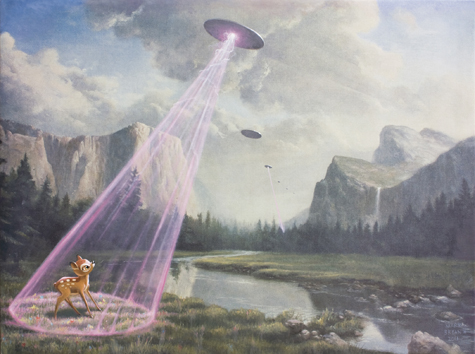
The Collectors
Some of Bryan’s own most recent political commentaries have been in the form of the sardonic Mad Tea Party series, of which the first painting he credits with launching his career as a full-time painter.
That painting was inspired by the Bush era, a time when Bryan remembers being really disturbed and unhappy with how right-wing politicians were handling things.
“I was trying to depict my feelings about it, and I thought the Mad Tea Party would be a great setting for them, because all the characters seemed so crazy,” he explains.
Little did he realize the extent that the painting would boost his popularity as an artist, or that several years down the road a Tea Party movement would emerge and that the right wing would embrace it.
At that point, there was no question that there would be a sequel to the original Mad Tea Party piece.
Bryan saw no shortage to the madness: BP had just dumped gallons of oil into the Gulf of Mexico, and Sarah Palin had essentially duped the Tea Party into making her their queen.
Thus, The Mad Tea Party Part D’uh was born, this time set against the beach. BP oil seeps into the ocean blue while Palin, dressed in Queen of Hearts garb, sits in the company of Rush Limbaugh reincarnated as the Mad Hatter and other right extremists, smirking devilishly while pouring Kool-Aid into teacups.
While he guesses that around a quarter of his work is political, Bryan says that he is not a political junkie. His paintings are more like outlets for comments he wants to make on human nature, whether or not they involve war, religion, left versus right or propaganda.
“I think an artist should be a person who reflects their feelings about the times and their own personal experiences, and so this is my particular take on what is going on in this world,” he says. “If I paint a landscape or something I usually have to put something else in it to make a comment, usually something disturbing,” he says.
Quite a few of his pieces peg religious fundamentalism, he says, because it’s an easy target.
“People in every moment in history think [the end of the world] is going to happen really soon, because everything is always so screwed up,” he says.
“In my lifetime I probably remember five or six of these guys saying the world is going to end.”
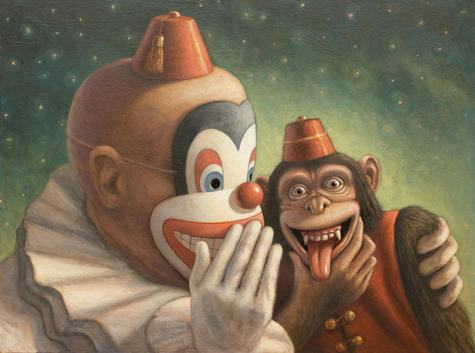
The Monkey Whisperer
Some inches further along the wall at the James Kaneko Gallery hangs an oil painting of a round-faced, beady-eyed man in a suit and tie. Capping the crown of his head is an automobile from which a crazed lucha libre rabbit is steering the wheel of his brain.
This piece, El Conejo in His Head, is one of a series of what Bryan calls his psychological portraits.
He offers a simple explanation: “Sometimes people behave in ways they don’t want to.”
Other pieces are parodies. For instance, Bryan’s Pushing Clocks depicts Salvador Dali against a barren landscape similar to that in Persistence of Memory, wheel-barrowing around a pile of his trademark melting clocks whilst dressed in a bunny suit.
This, Bryan says, was an easy way to drag Dali into the lowbrow, pop surrealism world.
Sometimes a painting is preceded with one to two sketches. At other times, paintings come a bit more spontaneously.
“I still start with an idea, like I’ll think I want to paint ballerinas and a landscape, but I have no idea what it’s going to look like,” he says. “It’s kind of a dreamlike process, they change a lot as I’m painting and a sort of picture or vision starts to crystallize slowly.”
Monkeys, rabbits and robots are some of Bryan’s go-tos used to incorporate humor into a piece, simply because he finds them inherently funny. Babies are another.
“Babies, you know, they are kind of creepy and I don’t know why I keep painting them,” he says. “And I put them in weird situations you never see them in, smoking cigarettes or boxing, stuff like that. Visually they’re fun to play with.”
For instance, another one of his parodies is Maja con Conejos, based on the painting La Maja Desnuda by a painter he adores, Francisco de Goya. Like Goya’s piece, Bryan’s is also of a shapely woman leisurely positioned on her side, except her head is replaced with that of a rabbit, and she is surrounded by a hoard of babies with rabbit heads.
If there is an underlying meaning to that painting, it is this: “The Maja, with all of her 25 babies or whatever, is to me like a cautionary tale to young men, like, ‘OK, sexual attraction, this is what it’s really all about. So, watch out,’” says Bryan.
Politics or parody, a touch of humor is most always to be expected in a Bryan piece.
“I use humor to make it palatable and seduce the viewer into actually looking at a picture,” he says. “I think humor gives you a little reward for looking at a piece, like satirical humor especially, it’s a way of getting the point across without turning off the viewer, or making it more appealing.”
Robots, the Washington Mall being taken over by armies while humans become sheep (as seen in The Republic of Suicide), the cynicism was all too familiar. It felt something like a Vonnegut piece.
When Submerge asked Bryan whether or not he was a Vonnegut fan, he responded, “Yeah. I love that guy.”
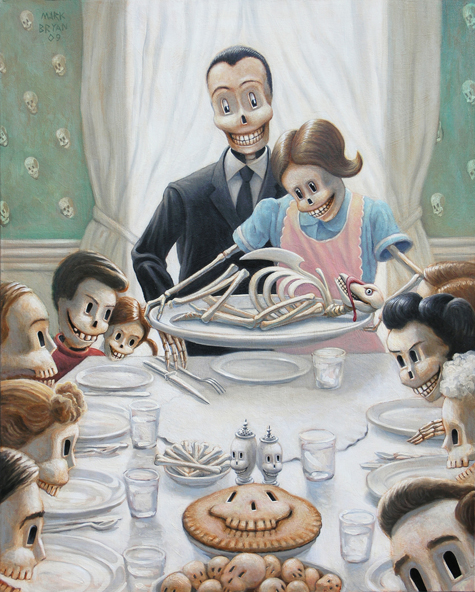
The Grateful Dead
Mark Bryan’s artwork is now being shown in The Rupture, an exhibit with Tony Natsoulus, at American River College’s James Kaneko Gallery. The exhibit will show now through Dec. 6, 2011. For more info on the exhibit, call (916) 484-8399. If you’d like to learn more about Mark Bryan, go to Artofmarkbryan.com.
After numerous projects, local musicians find a home in Mondo Deco
Sacramento is in the grips of another icy cold night in November. Twenty or so local musicians and music aficionados have escaped the cold, spread around the living room of an apartment talking over each other and wine.
This is a listening party, and these people are part of a tight-knit circle of friends who have been asked to be the first to hear local band Mondo Deco’s debut album, Pleasurefaith, a blend of ‘60s-esque pop rock combined with gritty rock ‘n’ roll. A friend of the band, I too stand in a circle of people as the album plays from the big speakers set up around the room.
“This is not a focus group,” vocalist Jeremy Greene and bassist Steve Robinson jokingly reassure us. They are, however, asking friends to listen for which song is their favorite.
Meanwhile, an ongoing slideshow of band photos plays on a TV screen. To hear the full sound of the album, I walk into the next room, passing the wall lined with electric guitars to one of four chairs where a pair of headphones awaits on a seat. This once average room has been transformed into a full-fledged recording studio. On the other side of the chairs is a former closet now functioning as a sound booth. To the right is a massive hand-built desk where the mixer and computer are set up.
This is where the mastered album we are now listening to was recorded, mixed and engineered by Robinson.
For the past several years, this apartment, Robinson’s apartment, has more or less become Mondo Deco’s headquarters. It’s where they rehearse, where they record and now where they have interviewed.
Only an hour before, I was sitting with three of the four guys in the group (minus drummer Billy Ewing) around the fireplace talking about the album and everything that has gotten them to this point.
It was two and a half years ago that Mondo Deco, named after the opening lyric from the one-hit wonder “Motorboat” by Jimmy Jukebox, became an official band, they tell me. That’s when “the magic happened.”
As Greene sees it, forming Mondo Deco came out of necessity. Up to this point, members have worked on their other local projects, including Matinee Idols, Wanchai Daggers, Electric Teenage Bedroom or GGM (formerly Goodness Gracious Me!).
But Mondo Deco is the band Greene and Ewing envisioned would get people moving and shaking again at local shows, engaging an audience to do something other than just stand around.
Reuniting long after high school when Ewing moved back to Sacramento from Monterey, Calif., the two began planning Mondo Deco. Greene found Robinson in his audio engineering class at Sacramento City College, and guitarist Kolton James would later be introduced through mutual friends.
The band was almost complete, except they knew they wanted a woman’s touch. They had go-go dancers and doo-wop girls in mind, or female-backed ‘70s funk bands like Sly & the Family Stone or Parliament.
Female counterparts would not only add another dimension to the songs and the live performances, but they would also provide a sexy element.
They discovered their girls soon enough. Keturah Gibson and Jessica Carter were added to the band as backing dancers and vocalists earlier this year. Gibson has more than 10 years of dance experience and Carter was recruited from a video shoot with local burlesque group the Sizzling Sirens.
As a six-piece, the band is now looking to shake up a local music scene that seems to have faded over the last three or so years.
“I think a lot of people would rather go to a DJ night, and we want to start to put on shows rather than just be the background music for people trying to get laid in bars,” Robinson says.
To sum it up, there is a widespread disinterest in live music these days, Greene adds.
This explains why Mondo Deco has had such a methodical approach to putting their music out into the Sacramento scene, whether it is in the form of an album or performance. Since their beginnings they have played a modest number of shows, perhaps 15 to 20. They have been selective of which shows to play around town and what nights of the week they fall on.
“Every single time we played, we wanted to reinvent the wheel with what we were doing live,” Robinson explains.
Along with the desire to be an attention-grabbing band, similar music taste is also a strong force in the group–throwback genres and what they agree are the greatest musical eras: the ‘50s, ‘60s and ‘70s. Names like Bowie, T.Rex, The Beatles or the Stones bear great weight.
Occasionally, newer music has been influential. For instance, James and Greene share an appreciation of The Raconteurs, which encouraged both of them to sing leads.
“I think that we all have an appreciation for what Jeremy adds as being a frontman, but we also do everything we can to bring him down from his pedestal,” Robinson says.
Keep in mind that while he maintains a straight face, half of what Robinson says is in jest.
He regains seriousness and continues, “There is a very deliberate effort for it to be a full band; everything should be a collaboration. There is an effort to make sure all of our egos are in check.”
“That’s why everyone sings in the group,” Greene adds.
Giving Pleasurefaith a listen, the vocals sound noticeably harmonized. This is because most of the vocals were recorded in the same room at the same time using a mid-side mic pair.
“We set up a couple of mics and really tried to feed off of the chemistry between us, rather than just tracking the vocals individually and placing them on top of everything,” Robinson says.
This pertains not only to the vocals, Greene points out. Most of the rhythm and beats were recorded live as well, in an attempt to keep the album as organic as possible.
Then they would incorporate effects. For instance, the tremolo effect or “wah wah” of the guitar is used in both “Lost Her Number” and “Young Man.” They recorded the guitar, sent it to another amp and upped the tremolo to give it a more “lush” sound.
On the first few listens, the lyrics on the album aren’t easily comprehensible. To write the songs, vocals are used more as instruments to match the musical arrangement of the songs.
“For the longest time I’ll just be throwing in garbage for lyrics that don’t really pertain to anything, they are just about the feeling,” Greene explains. “Cadence and melody and all that come first, and then you can piece in something that’s worth hearing, worth reading.”
Wordless melodies are then crafted into something meaningful. In “Far to Fall,” Greene and James describe an ominous telling of the apocalyptic ways in which the human race is doomed, either by the nuclear war, global warming or crashing economies.
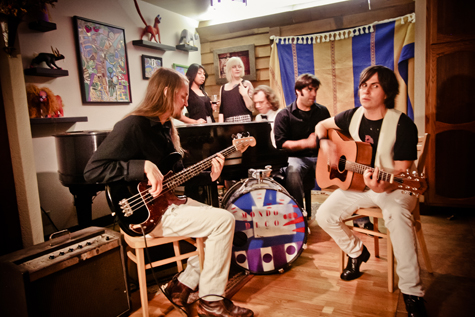
“A fun aspect for writing lyrics with this particular group is bringing in a sense of fable or storytelling in general…things that slightly hint toward Snow White or alchemy,” Greene explains. “All of these things are greater stories that are out there and have been for thousands of years. Why not write more about them?”
Like most newer bands, the band is still in the works of defining their sound. Despite the influence of the great musical eras, they strive to keep theirs unique.
“There’s way too much era rock going on these days. People have a hard time finding their own voice,” Greene adds. “But if you can pick and choose from what you really appreciate, different genres or different eras, you can kind of put your own twist on it.”
Now the band is in the mindset of releasing another EP within the next six months. Robinson suggests that while Pleasurefaith songs bear a more classic, ‘50s, ‘60s and ‘70s rock ‘n’ roll feel, some of the post-Pleasurefaith songs they have written in the past few months may be evolving into less predictable prog-rock territory, alluding to unconventional time signatures and tempos.
Now that they are a record deep, the clock is ticking to figure out a musical direction and birth the next record, Robinson says.
Aware of this clock, the group continues to methodically consider all options–putting out singles versus EPs or full-length albums.
“As much as the Sacramento music scene might be slightly dormant right now, I think there are people out there that want new music to constantly be coming on the horizon,” Robinson speculates.
“We want there to be an effort to actually captivate and get Sacramento bands to put some kind of conscious effort into putting on the kind of show that people want to pay to see.”
Pleasurefaith is a reference to this very idea. The album is named after a phrase from the Gregory Maguire’s novel Wicked that encourages hedonism and indulgence as the greatest good.
Robinson brings the conversation full circle.
“I think that idea that the most important thing, like the Holy Grail, is the pursuit of that enjoyment [is] an analogy of why we formed as a band,” he explains. “Music is something that we enjoy doing, but it’s also something that we want to be enjoyable to go see. We want to be a show that assaults the senses.”
Touch of Pink
District 30 – Wednesday, Oct. 26, 2011
If glitz is what you were looking for downtown Wednesday night, District 30 had it. The posh nightclub was holding its fall fashion series throughout the week, and this night was the Touch of Pink runway benefit show featuring the work of Sacramento designer Faatui Toele.
Inside, 20 to 30 people were spread around the bar. A few select individuals grinded, pinning each other against walls as DJ Nate D and company spun beats like Flo Rida’s “Low” or Lil John and the Eastside Boyz’s “Get Low” from a perch behind a tall wooden platform. Some people lounged in plush, long booths sipping drinks, while others settled into chairs lining the runway, helping themselves to glasses of champagne.
Despite the event being a breast cancer benefit, few wore even a touch of pink. Many were fashionably clad, nonetheless, sporting creepers, mini dresses, faux hawks, suit jackets, vests and platforms.
There were plenty of drinks to be had, as some leaned against the marble-top bar while heavy bass lines pulsed beneath their feet. Slowly people began to gather around the runway in anticipation beneath whirling lights, colorful birdcages and a spinning disco ball suspended from the ceiling.
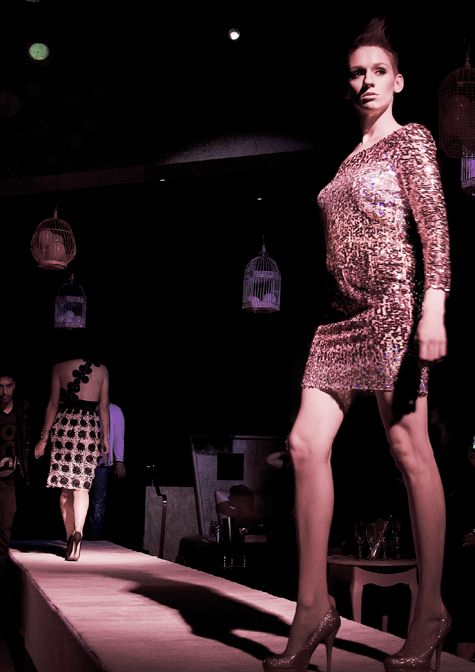
By the time the models emerged from behind the slinky black curtain onto the catwalk, 40 to 50 people crowded around to watch. The models were all legs and tresses. The first model pranced onto the stage dressed in high-waist sequined booty shorts and a sleeveless zebra-print blouse. Another appeared with a black, off-the-shoulder one-sleeve draped over a pink tube dress underneath. And yet another appeared sporting a red tube dress with a zip down front, her neck wrapped in long strands of crystals.
The audience was receptive, letting out supportive whoops and hollas. True, a few of the models could have used some coaching on both their swagger and poker face, looking a little uneasy approaching the crowd. Submerge couldn’t help noticing, however, a huddle of three or four noticeably obnoxious male spectators that couldn’t contain their urges to be heard, shamelessly blurting out, “Why is everyone cheering for that girl? Oh, it must be her family!”
The show went on. The models towered over the crowd in metallic stilettos and short ankle boots. The rest of Toele’s collection featured mostly black, skin-tight, thigh-high dresses, one-shoulder cuts and more sequins. Several models donned pieces with metallic zig-zag patterns, while other garments incorporated beading and more zippers. The designs were classic and sexy, though not particularly cutting-edge.
Toele modestly trailed behind the models onto the catwalk for the finale. Shortly after, the models reappeared from behind the curtains and got down on the dance floor, helping the crowd loosen up while the DJs returned to the turntables, churning tunes by Adele and the Red Hot Chili Peppers into the night.

